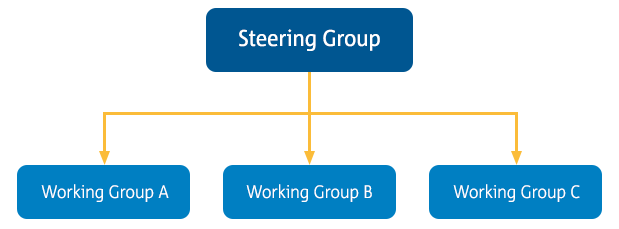EOFDM is the European forum for exchanging good practice on Flight Data Monitoring!
The European Operators Flight Data Monitoring forum (EOFDM) is a voluntary partnership between European Operators and the European Union Aviation Safety Agency (EASA) in order to:
- Facilitate the implementation of Flight Data Monitoring (FDM) by Operators
- Help operators draw the maximum safety benefits from an FDM Programme
Who can participate in the working groups?
Depending on the working groups (WGs) the following organisations may participate:
- Operators
- Operator associations
- Flight-crew associations
- Aircraft Manufacturers
- Flight-data-monitoring software vendors
- Research and educational institutions
- Regulators (national aviation authorities and international aviation regulators)
- If you would like to join EOFDM, please contact: fdm [at] easa.europa.eu
Non-european organisations are encouraged to join this safety initiative.
How are EOFDM working groups organised?

Steering group
Strategic decisions and coordination of the work produced. Composed by the leaders of the Working Groups (Industry) and the Secretaries of the Working Groups (EASA).
Download generic terms of reference (ToRs)
Working Group A - “Monitoring operational safety issues”
Scope
- Identify common risks and related operational issues that can be monitored by FDM programmes in order to support operators’ SMS programmes.
- Produce recommendations of specific operational issues to be monitored by an FDM programme.
Working Group A has adressed
- Runway Excursions (RE)
- Loss of Control In Flight (LOC-I)
- Controlled Flight Into Terrain (CFIT)
- Mid-Air Collision (MAC)
Download WGA Terms of Reference (ToRs)
Working Group B - “Programming and equipment related aspects”
Scope
- Define FDM algorithms needed for monitoring the operational issues recommended by EOFDM WGA.
- Identify techniques to investigate flight data, for automatic analysis and manual analysis.
- Define flight parameters performance (e.g. sampling rate, recording resolution, accuracy, etc.) needed for an effective FDM programme.
Working Group B has addressed:
- Runway Excursion (RE)
- Loss of Control In Flight (LOC-I)
- Controlled Flight Into Terrain (CFIT)
- Mid-Air Collision (MAC)
Download WGB Terms of Reference (ToRs)
Working Group C - “Integration of the FDM programme into operator’s processes”
Scope
- Best practice for the integration of FDM into an operator’s Safety Management System (SMS). This includes:
- The implementation of “safety culture” in an FDM programme;
- Integration of FDM data with other data sources to support the SMS processes;
- The balance between confidentiality and access to data for SMS purposes.
Working Group C has produced:
- Key Performance Indicators for an FDM Programme
- Memorandum of understanding for an FDM Programme
- “Breaking the silos”, fully integrating FDM into the SMS
Download WGC Terms of Reference (ToRs)
Current EOFDM projects
Currently, EOFDM activities are working on producing best practice regarding:
- Advanced FDM algorithms for incorrect altimeter settings;
- How the FDM programme can support the safety risk management (SRM) process of the operator and the objectives of flight crew training.
EOFDM is the action owner for the following Safety Promotion Tasks (SPT) of the European Plan for Aviation Safety (EPAS) 2024.
- SPT.0126 - Integrating the flight data monitoring (FDM) programme with safety risk management (SRM) “Produce good practices for integrating the FDM programme with the operators’ SRM, with a focus on risk assessment and on supporting flight crew training”. (delivery target: 2024/Q4)
EOFDM Evaluation
An evaluation of the impact of EOFDM activities was performed during 2019 to assess the awareness and the implementation of the EOFDM best practice documents among European operators (evaluation task EVT.0009 of the EPAS for 2020–2024). The evaluation report is available at the link below.
Contacts
For any queries concerning EOFDM, please contact: fdm [at] easa.europa.eu (fdm[at]easa[dot]europa[dot]eu)
Publications / Documents
Disclaimer: The documentation provided on this webpage results from the cooperative work performed by EOFDM members. It is industry good practice resulting from the experience on FDM from the working groups members, and it should not be confused with guidance material or acceptable means of compliance to EU rules.